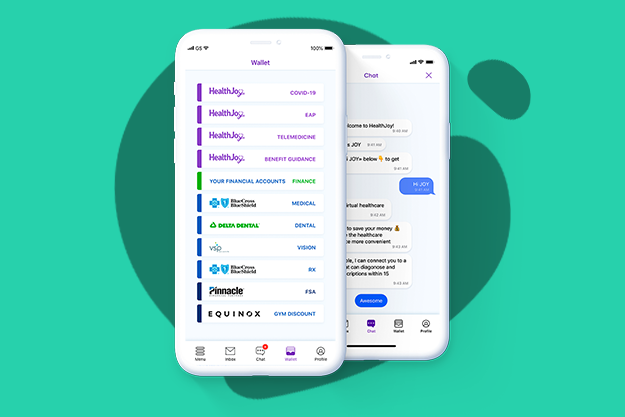Why EAP Understanding is More Important Than Ever
We’re approaching 2021 open enrollment under a cloud of mental health concerns. Employees are struggling like never before, and it might feel like...
Connected Navigation Platform
Guiding to high-value care
Behavioral Health
Foster a mentally healthy workplace
EAP
Supporting holistic wellbeing
Virtual MSK Care
Reimagining musculoskeletal care
Virtual Primary Care
Powered by smart navigation
Surgery Centers of Excellence
Best-in-class surgical outcomes
Virtual Urgent Care
Immediate care, any hour of the day
Chronic Care
A new approach to chronic care
Integrations
Flexible to any strategy
5 min read
 Claire Wiseman Imber
:
November 10, 2021
Claire Wiseman Imber
:
November 10, 2021

With an estimated 50% of employees working remotely in 2022, HR professionals are facing massive changes to the way they’ve traditionally communicated employee benefits. With massive change on the horizon, though, there’s never been a better time to revisit your benefits communication strategy.
According to our 2021 Benefits Insights Report, employee communication isn’t meeting employee expectations. On a scale of one to 10, employees ranked their HR teams’ benefits communications an average of six. That could be due to a disconnect between what they get and what they need.
For instance, when employees have questions, over half will turn to their benefits guides first. But when asked what benefit communications methods they prefer, apps and email won out over benefits guides.
Let’s compare that to how we know HR planned to communicate during open enrollment and beyond.
Our 2021 State of the Benefits Experience Survey of HR professionals found that 99% of respondents planned to use paper or online enrollment materials, 97% planned to use email, and 77% planned to use in-person meetings. App notifications clocked in at 21%, while 13% planned to use Slack, Microsoft Teams, or another chat tool to communicate benefits.
Newly remote workforces, piling pressures that compete for employee engagement, and the additional complexity of OSHA compliance procedures threaten to push simple open enrollment communications to complete obsolescence. So this year, achieving success with the communication strategies we’ve always relied on is an even tougher proposition. To get ahead of the wave, HR must update its communication strategies.
Here’s how.
As we’ve said before, you should really just kill your benefits booklet. Benefits booklets are often discarded, buried in a desk, or simply ignored. It doesn’t matter whether you mail it home or make it accessible through your intranet. Any static document is likely to be skimmed during open enrollment and then abandoned without any meaningful retention. That means that when workers actually need to use their employee benefits, they won’t know what’s on offer or where to look.
Healthcare literacy rates in the U.S. are already low, and we know that employees who don’t have on-demand answers may choose low-value care. Effective communication materials are essential to keeping healthcare costs low.
If you aren’t ready to toss your benefits booklet all together, consider shoring up your enrollment materials and internal communication with a year-round communication plan. Backing up the booklet with email campaigns, push notifications and/or text messages, messaging platforms like Slack, and a centralized healthcare navigation experience can smooth dips after benefits booklets are dumped.
First up, let’s talk about email.
Emails are practically begging to be ignored, especially when your employees see that the subject is their benefits. You can maximize the likelihood employees will act on important to-do’s or retain helpful info by overhauling your email strategy.
In short, we know you’ll be sending emails about benefits, so take a few minutes at the beginning to update your strategy. A little goes a long way!
Your employees probably don’t want more video-based learning. Over the last week, I had 18 hours of video-based work meetings, an hour-long Zoom appointment with a doctor, took a 2.5-hour Zoom-based writing class, and met with my Zoom-based book club for an hour. That was a light week, and I don’t have children. But if your company is working remotely (or just trying to minimize gatherings during the second wave) you’re likely stuck with video meetings for now. A few ideas to keep them engaging:
Give an incentive worth having – If attendance is an issue, consider an incentive. Yes, incentives really do increase engagement. Just make sure it’s something they want. Enter employees into a drawing if they hang around until the last slide, or have them text a number you give out at the meeting’s end to get a Starbucks gift card.
Keep meetings interactive – Today, I referred to the monotasking it took to write this post as “a real treat.” That’s because multitasking has become the order of the day. Setting an expectation of focus and rewarding it with a truly captivating presentation can help employees stay engaged. Engagement = retention. This list from Fearless Presentations has a few quick tips, like using the Zoom whiteboard and setting expectations in the invite notes. You can also think back to the best TED Talk, virtual presentation, or hosted happy hour you’ve ever attended and ask “what made me want to pay attention?”
Or consider Audio instead of video – As an alternative, consider encouraging your people to take an audio-only meeting. Whenever possible, I take webinars or video-off meetings to my treadmill so I can walk while working. Set your benefits meeting up as an audio-only webinar, and ask them to mask up and head out for a walk. There isn’t much downside here: studies on walking and walking meetings show we’re more creative when we’re moving, and a survey from the Harvard Business Review found employees who participated in walking meetings reported 85% higher engagement. If you follow up with an email that contains action steps, you might actually give employees better notes than they’d ever taken while multitasking at their desks.
App notifications are a powerful way to quickly grab your employees’ attention. In fact, 28% of those we surveyed last spring told us they prefer to receive their benefits communications via an app. This option won out over email (23%), benefits guide (18%), or video/in-person meetings (8%).
Yet, just 20% of the HR pros we surveyed in 2020 said they’re making use of this technology. If you’re one of the unconvinced 80%, consider this: in a Localytics study, app users who received push notifications had 53% more sessions than app users who didn’t get notifications. Apply that to benefits: an app that centralizes your benefits can capitalize on push notifications to get details in front of far more employees than a static booklet or even an email. If that’s not an option, the good news is that SMS notifications are equally compelling. A study in the UK found that 98% of mobile users will read a branded or business-based text communication-90% within the first 3 minutes.
For 2022, you can update this strategy by tailoring your messages to align with best practices. Our attention is more divided than ever, so analyzing metrics like open rates and polishing up your copy is essential. This article from Stephanie Trunzo for Retail Dive has helpful tips for retail marketers, but I think this advice is universally applicable: “we have to be careful to create content that adds value, not noise.”
If a Slack notification has ever pulled you away from a Sunday spent lounging on your couch, you know just how powerful these tools can be. About 13% of the HR pros we surveyed reported using chat tools for their benefits communications. Yet we know that these tools are surging in popularity, especially among office workers. If you weren’t using Slack or Teams before March 2020, you probably are now.
You can update this strategy for 2022 by crafting messages tailored to the way your team communicates on chat. Do you have a Slack channel dedicated to official announcements or company news? Are emojis the norm for all-company announcements?
Then, consider which information is best suited to these channels. Which details, action items, or deadlines are best suited to this space?
Non-specific reminders, like general announcements, enrollment dates, or company-wide plan change details could be posted and pinned in these chat tools for easy referral. Create a Benefits channel in Slack to post only the most pertinent info, which can keep employees from getting fatigued by constant messages. Remember that these communication channels run both ways, and that’s a good thing. For instance, you could install a poll app to get an idea of where employees are struggling. Just don’t neglect a tool that you are likely already paying to use.
Updating your benefits communication strategies for 2022 is as simple and as complicated as meeting employee expectations. Dig into the strategies you’ve used before and tweak where needed. If your employee population has changed significantly over the last few years, is newly remote, or is relying on benefits in a different way, build your strategy around those facts. Above all, remember the goal of your benefit communications: to empower employees to use their benefits, live healthier, and overall, have a better employee experience.

We’re approaching 2021 open enrollment under a cloud of mental health concerns. Employees are struggling like never before, and it might feel like...

1 min read
Building a genuinely satisfying employee benefits package is at the top of every HR professional’s mind, but getting there is harder than ever...

There’s a lot to consider during open enrollment, and it can be easy to focus on the new benefits you’re rolling out to employees. But taking time to...